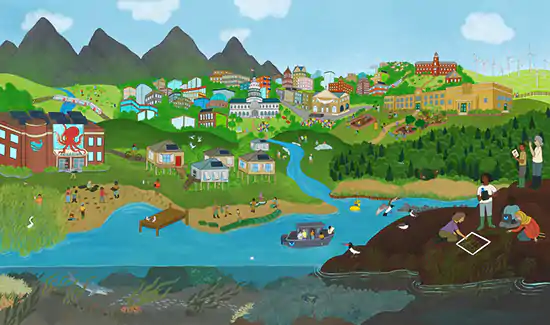NOAA's Community Resilience Education Theory of Change

NOAA’s Environmental Literacy Program (ELP) Community Resilience Education Theory of Change communicates the overarching philosophy guiding its grants program. ELP supports projects that both inspire and educate people to use Earth system science to increase ecosystem stewardship and resilience to extreme weather, climate change, and other environmental hazards.
A theory of change is broad in scope and begins with a problem statement and ends with a goal. In between, causal pathways systemically lay out the steps, or short-, mid-, and long-term outcomes that must be met to achieve the end goal.
How did we develop this theory of change?
We consulted numerous sources in the development of this theory of change. The community resilience education projects funded by ELP served as the primary basis for the theory of change. We also consulted relevant theories of change from other programs and conducted an extensive review of published literature in related fields.
Who should use this theory of change and how?
This theory of change serves multiple purposes and audiences. It demonstrates the ways in which the ELP fills a gap in resilience-building approaches more commonly underway. NOAA’s other resilience investments are focused on creating and promoting the use of science-based information and training for adults to apply that information within the context of their professions. While building the capacity of adults to use this information in a professional context is essential, so is equipping community members with the environmental literacy necessary to make informed decisions about the place-based challenges they face outside of a professional context. When community members engage in informed decision making, the efforts of resilience practitioners and local or state officials engaged in building community resilience are further supported. Our theory of change outlines how this occurs and therefore, may be useful by our colleagues at NOAA, other government offices that support resilience efforts, resilience practitioners, and philanthropic organizations with similar interests. We also see the applicability of this resource to education professionals and environmental non-governmental organizations.
Our grantees can use this as a framework for understanding and mapping how their local efforts contribute to a broader, national effort to increase resilience. More specifically, we intend for our grantees, their partners, and ELP applicants to use this resource to inform project-level logic models and related evaluation, ensuring that their project’s activities and outcomes are aligned with the overall ELP outcomes and goals.
Finally, we will use the theory of change to aggregate effective approaches and outcomes identified by our grantees in the future and help us continue to demonstrate the value of education in community, city, state, and national efforts to build community resilience to extreme weather, climate change, and other environmental hazards.
The Community Resilience Education Theory of Change is a living document that will be updated regularly to reflect progress made by ELP, as well as other contributions to the field of community resilience education.
Where can you find more information?
The “Report on the NOAA Office of Education Environmental Literacy Program Community Resilience Education Theory of Change” contains the complete theory of change, an overview of the Environmental Literacy Program history and evolution, an in-depth literature review, and an explanation of how to navigate the theory of change. A comprehensive glossary and bibliography are also included.

